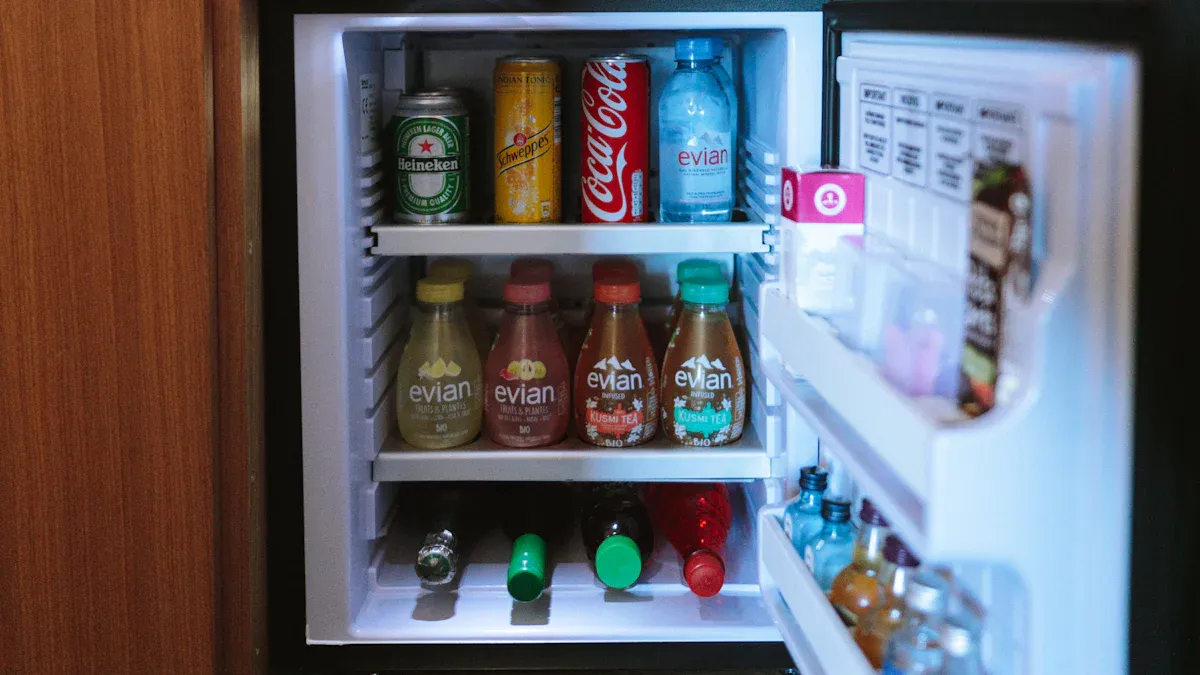
A mini car refrigerator transforms road trips, camping, and everyday commutes by keeping food and drinks fresh on the go. Efficient use of this portable fridge reduces energy consumption and extends its lifespan. With proper handling, a portable car refrigerator ensures convenience while preserving perishable items. Treating it like a freezer refrigerator safeguards its performance.
Pre-Trip Preparation for Your Mini Car Refrigerator

Proper preparation ensures that a mini car refrigerator operates efficiently during trips. Following these steps can help maintain cooling performance and reduce energy consumption.
Pre-cool the refrigerator before loading
Pre-cooling the mini car refrigerator is a crucial step before loading any items. Plugging it in 30 minutes to an hour before use allows the unit to reach the desired temperature. This practice minimizes the initial power demand on the car battery, ensuring smoother operation once the journey begins.
Tip: Pre-cooling at home using a standard power outlet is more energy-efficient than relying on the car’s battery.
Pack items strategically for airflow
Packing items inside the refrigerator requires careful planning to maintain proper airflow. Leaving 20–30% of the space empty prevents hotspots and ensures even cooling throughout the unit. Heavier items, such as beverages, should be placed at the bottom, while lighter items like snacks can go on top. This arrangement optimizes cooling efficiency and makes it easier to access frequently used items.
| Strategy | Explanation |
|---|---|
| Pre-cooling the fridge | Plugging in the fridge 30 minutes to 1 hour before loading helps reach the desired temperature. |
| Smart packing | Leaving 20–30% space for air circulation prevents hotspots and ensures even cooling. |
| Routine maintenance | Regular cleaning and checking seals improve hygiene and efficiency, reducing strain on the fridge. |
Clean and defrost before use
Cleaning and defrosting the refrigerator before each trip is essential for hygiene and performance. Residual frost can reduce cooling efficiency by creating a barrier between the cooling elements and the stored items. Wiping down the interior with a mild cleaning solution removes odors and bacteria, ensuring a fresh environment for food and drinks.
Note: Regular maintenance, including checking the door seals, prevents cold air from escaping and reduces energy consumption.
By following these pre-trip preparation steps, users can maximize the efficiency and lifespan of their mini car refrigerator while enjoying fresh and safe food storage during their travels.
Energy-Saving Tips for Mini Car Refrigerators
Limit door openings to retain cold air
Frequent door openings can cause a mini car refrigerator to lose cold air rapidly, forcing the compressor to work harder to restore the temperature. This increases energy consumption and reduces efficiency. To minimize this, users should plan ahead and retrieve multiple items at once instead of opening the door repeatedly. Storing frequently used items near the top or front of the refrigerator can also reduce the time the door remains open.
Tip: Encourage passengers to decide what they need before opening the refrigerator to save energy and maintain consistent cooling.
Park in shaded areas to reduce heat
Parking in shaded areas significantly reduces the external temperature around the mini car refrigerator, which helps it maintain its internal cooling with less effort. Empirical data shows that areas with higher vegetation density provide better cooling effects. For example:
| Vegetation Density (%) | PLE Value |
|---|---|
| 0 | 2.07 |
| 100 | 2.58 |
| Average PLE Range | 2.34 – 2.16 |
This data highlights the importance of shade in reducing heat exposure. Parking under trees or using a car sunshade can make a noticeable difference in the refrigerator’s energy efficiency. Lowering the ambient temperature reduces the strain on the unit, extending its lifespan and saving energy.
Activate ECO mode for efficiency
Many modern mini car refrigerators come equipped with an ECO mode, which optimizes energy consumption by adjusting temperature settings and compressor activity. Activating this mode can lead to energy savings of up to 15% annually. For the average American household, this translates to approximately $21 in savings each year. ECO mode achieves these savings by maintaining a stable temperature range and reducing unnecessary power usage.
Note: ECO mode is particularly useful during long trips or when the refrigerator is not fully loaded, as it balances cooling performance with energy efficiency.
By following these energy-saving tips, users can maximize the performance of their mini car refrigerator while reducing operational costs. These practices not only save energy but also contribute to the longevity of the appliance, ensuring it remains a reliable travel companion.
Safety and Maintenance Practices
Ensure proper ventilation around the unit
Proper ventilation is critical for the efficient operation of a mini car refrigerator. Restricted airflow around the unit can cause the compressor to overheat, reducing its lifespan and cooling performance. Users should place the refrigerator in a location where air can circulate freely around the vents. Avoid placing it against walls or other objects that block ventilation.
Tip: Maintain at least 2–3 inches of clearance on all sides of the refrigerator to ensure optimal airflow.
Inspect power cables and connections
Regular inspection of power cables and connections prevents electrical issues and ensures safe operation. Frayed wires, loose plugs, or damaged connectors can lead to power interruptions or even pose fire hazards. Users should check the cables for visible signs of wear before each trip. If any damage is detected, replacing the cable immediately is essential.
- Checklist for cable inspection:
- Look for exposed wires or cracks in the insulation.
- Ensure the plug fits securely into the power outlet.
- Test the connection to confirm consistent power delivery.
Routine inspections help maintain the refrigerator’s reliability and protect the vehicle’s electrical system.
Set the correct temperature for food safety
Maintaining the right temperature inside the mini car refrigerator is vital for preserving food safety. Perishable items like dairy, meat, and seafood require a temperature below 40°F (4°C) to prevent bacterial growth. Users should adjust the thermostat according to the type of items stored. A digital thermometer can help monitor the internal temperature accurately.
Note: Avoid setting the temperature too low, as it may freeze items unnecessarily and increase energy consumption.
By following these safety and maintenance practices, users can ensure their mini car refrigerator operates efficiently and safely, providing reliable cooling for every journey.
Accessories to Boost Mini Car Refrigerator Efficiency

Use solar panels for sustainable power
Solar panels provide an eco-friendly and cost-effective way to power a mini car refrigerator. They harness renewable energy from the sun, reducing reliance on the vehicle’s battery. Portable solar panels are lightweight and easy to set up, making them ideal for outdoor adventures. Users can connect the panels directly to the refrigerator or use them to charge a backup battery. This setup ensures uninterrupted cooling, even during extended trips. Solar panels also help reduce carbon emissions, aligning with sustainable travel practices.
Tip: Choose solar panels with a wattage rating that matches the refrigerator’s power requirements for optimal performance.
Add insulated covers for better cooling
Insulated covers enhance the cooling efficiency of a mini car refrigerator by minimizing temperature fluctuations. These covers act as an additional barrier, reducing heat transfer between the refrigerator and its surroundings. Research shows that insulated systems can maintain temperature fluctuations within 1.5°C over 2.5 hours. Without insulation, fluctuations in the cold zone can exceed 5.8 K. By using insulated covers, fluctuations in the cold zone drop to 1.5 K, a 74% reduction. This improvement ensures consistent cooling, even in hot environments.
Note: Insulated covers are especially useful during summer trips or when the refrigerator is exposed to direct sunlight.
Keep a backup battery for emergencies
A backup battery ensures the uninterrupted operation of a mini car refrigerator during power outages or long trips. These batteries store energy and provide an alternative power source when the vehicle’s battery is unavailable. Lithium-ion batteries are a popular choice due to their lightweight design and high energy density. Some models even feature USB ports, allowing users to charge other devices. A backup battery not only prevents food spoilage but also protects the refrigerator’s compressor from sudden power interruptions.
Tip: Regularly charge the backup battery to ensure it is ready for use when needed.
By incorporating these accessories, users can significantly enhance the efficiency and reliability of their mini car refrigerator. These tools not only improve cooling performance but also ensure a seamless experience during every journey.
Efficient use of a mini car refrigerator enhances travel convenience while preserving food quality. Preparation ensures optimal performance, energy-saving practices reduce costs, and safety measures protect the unit. Accessories like solar panels and insulated covers improve reliability. Applying these tips allows users to enjoy seamless cooling during every journey.
FAQ
How long can a mini car refrigerator run on a car battery?
Most mini car refrigerators can run for 4–6 hours on a fully charged car battery. The duration depends on the refrigerator’s power consumption and the battery’s capacity.
Tip: Use a backup battery or solar panel to extend runtime during long trips.
Can I use my mini car refrigerator indoors?
Yes, mini car refrigerators work indoors when connected to a compatible power adapter. Ensure the adapter matches the refrigerator’s voltage and wattage requirements for safe operation.
What is the ideal temperature setting for a mini car refrigerator?
Set the temperature between 35°F and 40°F (1.6°C–4.4°C) for perishable items. Adjust the setting based on the type of food or beverages stored.
Note: Use a digital thermometer to monitor internal temperatures accurately.
Post time: May-26-2025

